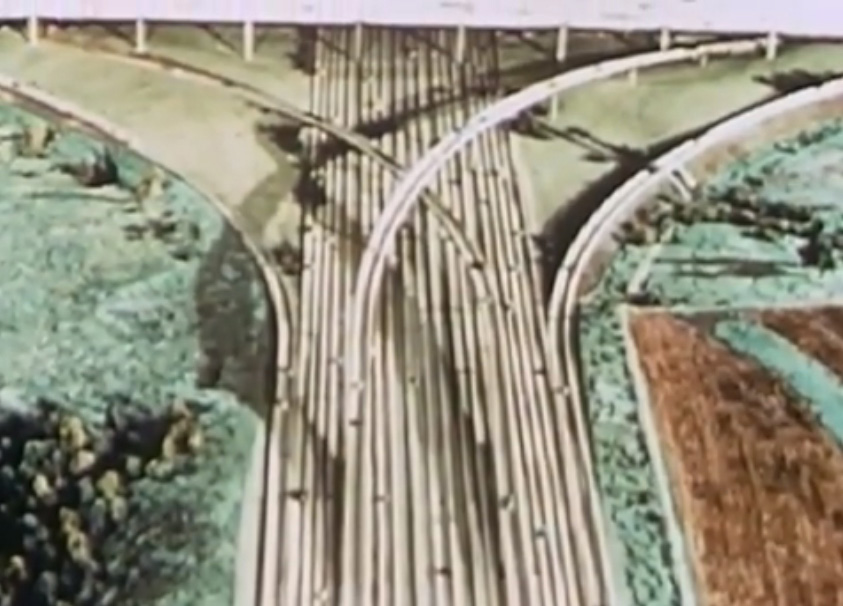... The Final Frontier ...
Michael Stone-Richards
I had the new sensation that the air was touching things; that the space between things touched them, belonged in common; that space itself was revealed.
Adrian Stokes, Inside Out: An Essay in the Psychology and Aesthetic Appeal of Space, 1947
I believe that the anxiety of our era has to do fundamentally with space, no doubt a great deal more than with time.
Michel Foucault, “Of Other Spaces,” 1967 / 1984
Over space, man has begun to win victory.
Futurama: To New Horizons, General Motors, 1939 New York World Fair
When considering what the principal theme of the inaugural issue of Detroit Research would be there was, in a sense, little doubt: space(s). Detroit has a lot of it, 138 (or 139) square miles of it, of which 40 square miles is vacant space. The readily available clichés – we all know the relevant figures off by heart - tell us that within this square mileage one could fit Manhattan, Boston, and San Francisco. In his recent book – part memoir, part urban analysis and social critique – journalist Mark Binelli begins a chapter on “How to shrink a Major American City” with the limpid declaration: “There was no getting around it: Detroit had too much space.” Major exhibitions at Cranbrook Art Museum and MOCAD (in 2007) were devoted to Shrinking Cities; nature was returning, taking over (or reclaiming) urban spaces as pheasants and assorted game could be spotted in certain parts of town; properties may be cheap but services are wanting. Many young artist types recently relocated to Detroit when asked why they had moved to Detroit could scarcely find anything more compelling to say than, It’s cheap. The list of privations could easily be extended.
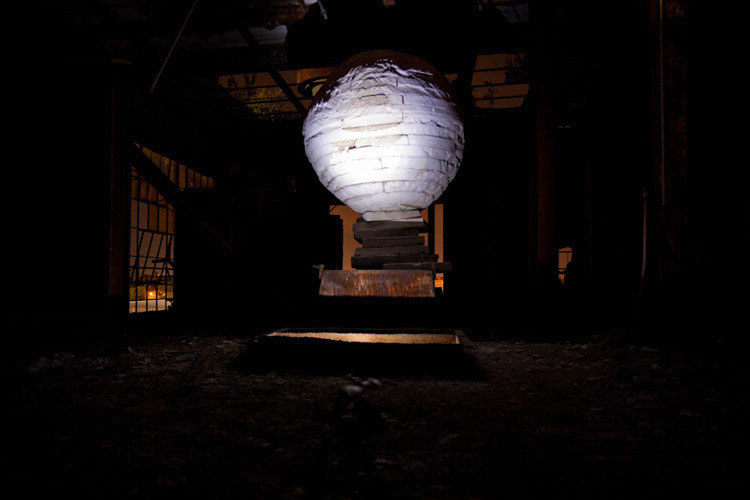
Sisyphus and the Voice of Space, 2010.
Courtesy of Scott Hocking and Susanne Hilberry Gallery.
The bleeding loss of population density has only served over the decades to dramatize the de-industrialization and de-population of Detroit which, after the last census in 2010, seemed to suggest that a tipping point had been reached.
This is a far cry from the vision, the city of the future, the city of tomorrow set out in splendid Technicolor in GM’s To New Horizons, its futurama film for the 1939 New York World Fair. “Mentally and physically,” says the voiceover, “we are progressing toward new horizons.”1The film can be watched at YouTube https://www.youtube.com/watch?v=1cRoaPLvQx0 To get a picture of these new horizons, the futurama invites us to “travel into the future [of 1960], this wonderworld of 1960,” where, one learns, “The accelerating rate of Man’s progress in all fields of endeavor has paralleled closely our progress in the freedom of movement from place to place,” this wonderworld in which “more desires have developed to be satisfied.” The future, of course, is a future for the motorcar, a future with “Highway engineering at its most spectacular”, where “The motorway continues through the mountains. Without tedious travel, the advantages of living in a small town are within easy reach, bringing the people who live there into closer relations with all the world around. [And here the immortal lines, O reader] Over space, man has begun to win victory. Space for living, space for working, space for play. All available for more people than ever before.” One does not need to be a follower of Jane Jacobs or Louis Chevalier (author of The Assassination of Paris so admired by Guy Debord) to see this wonderworld of 1960 as an utter nightmare – the color of the future even looks like the landscape of a Bosch painting. The point, however, is not to critique this old film – it even has a certain camp value in its voiceover and Technicolor! – which would teach us nothing; rather it is to remind ourselves that its politics of space were the practice not of GM but of a whole profession of urban planners whose influence could best be grasped as a form of Centralized Democratic Bureaucracy: across the country, almost without exception, modernist urban planning had near uniformity of practice and destructive impact. When the voiceover in GM’s futurama says that in this wonderland of 1960 “Residential, commercial and industrial areas, all have been separated for greater efficiency and greater convenience,” just as “On all express city thoroughfares, the rights of way have been so routed as to displace outmoded business sections and undesirable slum areas whenever possible [for] Man continually strives to replace the old with the new,” this is not GM pure and simple but the commonplace of a profession whose form of Centralized Democratic Bureaucracy was projected through federal government policy the cornerstone of which was the National Housing Act of 1934 and the Housing Act of 1949 which established “as a national goal, the realization of a ‘decent home and suitable environment for every American family.’”2“Housing,” The Kerner Report, Report of the National Advisory Commission on Civil Disorders (New York: Bantam Books, 1968), 467. If there are I-75’s and I-94’s through Detroit and many if not all American cities – most notably Greenwich Village, New York – it is because so few American cities had a Jane Jacobs and the social, cultural, and intellectual capital to resist one of the most powerful forms of Centralized Democratic Bureaucracy ever envisaged.
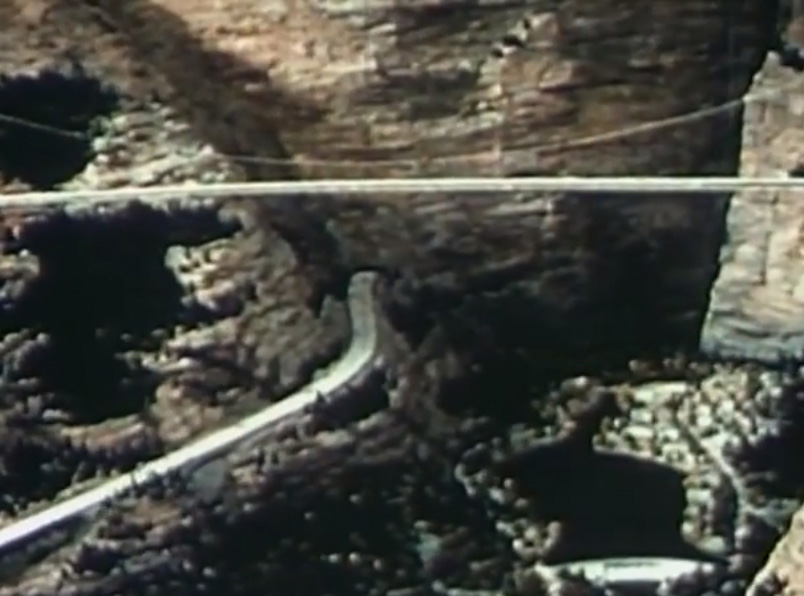
The motorway continues through the mountains
To New Horizons, 1940. Photogram.
If, in America, Jane Jacobs symbolically delegitimized the urban planning profession in its imperialist mode, it would not be until Richard Nixon – yes, Richard Nixon – that, between 1973-1975, the effective universal power of urban planning orthodoxy would be contained with the halting of urban renewal plans and the devolution to state and local bodies of powers over housing once invested in the federal government, starting with the invidious subsidies for both the demolition of existing urban fabrics condemned as blighted and the concomitant expansion of the suburbs at the expense of cities. We are all, from Detroit to Paris, living in the wake of this failed futurism captured in glorious Technicolor in GM’s futurama To New Horizons…
If urban planning no longer has the authority to impose a uniform vision upon a reluctant citizenry, it remains that much of the language of urban planning is operant, especially the language of blight which is used, in the absence of social or urban imagination, to license the demolition of structures and to render space abject. It is in this context that should be placed one of the most important events for urban and spatial thinking in the cultural economy of recent Detroit. The publication of Detroit Future City: 2012 Detroit Strategic Framework Plan, which will shape much of public official discourse even if relatively few of its proposals will see the light of day, is a telling and fascinating document dominated as its rhetoric is by time, which is to say urgency: it is, though, the Future City, and “Detroit is closer to its future than we imagine” which is touched on in a preface or Forward – get it? – “Forward: Leading Detroit toward its Future,” followed by “Blueprint for Detroit’s Future” and “The Time is Now.”3Cf. Detroit Future City: 2012 Detroit Strategic Framework Plan (Detroit 2013), 1-13. When, however, the content of Detroit Future City comes into play the content is all space, places, and what to do with them, all is, indeed, a politics of space in search of an ethic of space and spatial justice.4Cf. the recent collection at the intersection of activism, social practice and critical theory of space, Andrea Phillips and Fulya Erdemci, ed., … Nothing makes this clearer than the proliferation and varieties of maps and mappings in Detroit Future City. Admirable though this document is – and there is a need for such a document to focus the conversation since no official body of the City Council of Detroit on its own is in a position to organize or undertake the needed research – its treatment of space is too functional, limited and, dare one say, diminishing – there is no poetry there - for it is not deferred time (for the future never arrives) but deferred space which is the current problem in Detroit. Space is housing, space is work, space is social and political interaction – this much is something on which we can all agree - but if Detroit becomes its own frontier – as envisaged in the “right-sizing” of the city in Detroit Future City - then it will remain locked, frozen into its current networks of voids and absences; in other words, Detroit’s frontier needs to be re-conceived in the widest regional and porous terms to encompass, say, Windsor – there are more bridges over the River Seine in Paris than over the Detroit River which separates and links one of the greatest trading routes in the world – no less than Grand Rapids. Just as we are learning to daylight buried streams so might we learn from nature’s own set of interconnections and inter-zones (which is to say, free movement) and come to realize the artificiality of our boundaries – nationally, regionally, and locally. Regional space, however, is not merely the space of trading routes, but also of spiritual expansion and the encounter with social complexity. One looks in vain in much current spatial research on Detroit for any acknowledgement of spaces of play of, indeed, play5Even GM’s futurama spoke of space for play, though there was not the slightest idea of what this could be. as a fundamental need, something which the economist Amartya Sen and the moral philosopher Martha Nussbaum and many more have come to argue.6Cf. Martha Nussbaum, “Central Human Functional Capabilities,” Women and Human Development: The Capabilities Approach (Cambridge : CUP, 2000), 1 …
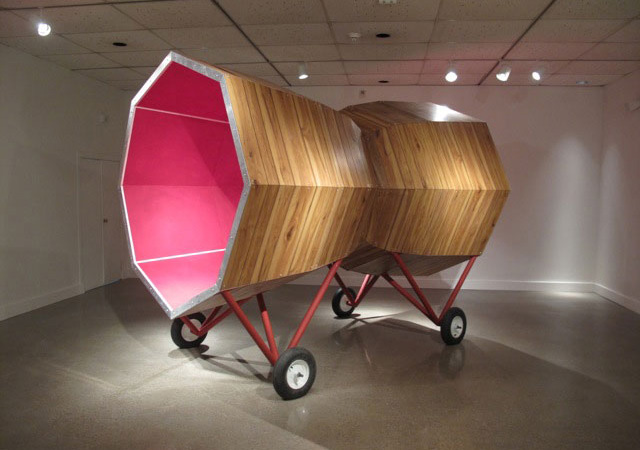
^Graem Whyte Make Love Not War (2012). Latex on modified ping pong tables, wood paneling, aluminum, steel, wheels, 6′ 4″ x 8′ 4″ x 11′. Image courtesy of the artist.
On the Social Practice scene in Detroit it is precisely the ethic of space with a profound sense of play and playfulness that one finds being explored. As an emblem of this marked tendency in the Social Practice and art on the Detroit scene, one may consider Katie Yamasaki’s mural overlooking an urban garden at 2nd Avenue and Brainard in midtown. It depicts a portrait of a young girl alongside three boys on a tire swing, and in the space between the two is written the following quotation from Grace Lee Boggs – the work was commissioned by the Boggs Center: “We need to combine learning with work, political struggle, community service and even play.”) And even play. Everywhere one can observe the preoccupation with space and play, for example, Graem Whyte, Faina Lerman and friends’ complex in Hamtramck called Popp’s Packing part of which is a Squash House, 2012-2013 with its re-appropriation of a deteriorated building for the construction of a new type of playing of urban squash; Whyte has also made new fields of play and gaming in the construction of new forms as embodied in his Make Love not War, 2012 made from modified ping-pong tables joined as two octagonal tubular forms joined in a cinched but open center. In such an imagined form play becomes an act of reciprocal choreographic imaginations and not the following of pre-existing rules of a game (whose purpose is winning). Whyte and Lerman have also composed a fascinating, simple and compelling field of play called Memory Field, 2010, a form of earth sculpture in layered rings incorporating groundcover, drainage system, and cistern in and around which children can play in open and new ways.7On Graem Whyte cf. Dick Goody, Remain Calm: The Art of Graem Whyte (Oakland University Art Gallery, 2012). There is, too, the PowerHouse Project, with its Play House (a community performing arts center), and Skate House which abuts the Ride It Sculpture Park (along the East Division Freeway), not to mention Jon Brumit’s Sound House (a novel sound and recording studio where the house itself is treated as percussive medium) which are further examples of the exploration of spatial forms which necessitate of the participants the open behavior in a new field of composition, behavior of the kind called play. Indeed, one of the strongest aspects of the new kind of art practices emerging on the Detroit scene is the exploration of place in a space between the strictly and narrowly private and the public, in which people explore forms of association intimate yet neither private nor public, hence the role of the many dinner gatherings whether in and around urban gardens (Kate Daughdrill) or in a space such as Detroit Soup run by Amy Kaherl (which brings together a greater social diversity than any other art space in Detroit), or as organized by Phil Cooley’s Clandestine dinners in out of the way locations and buildings/structures (which seek to activate abandoned buildings through underground dining experiences), or in the home which is also a studio and place of wider association (part expanded kitchen, living area, part lieu de passage), or, even, in larger cultural practices such as the new venue of Culture Lab Detroit initiated by Jane Schulak in 2013 which, for example, organized a conversation on Social Practice, architecture and design with Theaster Gates, David Adjaye and the Campano brothers followed by a dinner at the local venue Le Petit zinc. The studio of a Scott Hocking, for example, is one of the great distinctive spaces and meeting places for resident artists and visitors to Detroit worthy of comparison with some of the great poet and artist studios of modernism; to visit Jon Brumit and Sarah Wagner’s studios is to visit, at the same time, their urban gardens and get a sense of how they interact with their social environment; to get to know the Columbia trained conceptual sculptor Ben Hall is also to get to know his Russell Street deli in Eastern Market as an extension of his practice; Phil Cooley’s Ponyride complex has become the housing for an assortment of diverse artists, architects, and social entrepreneurs of which Veronika Scott’s Empowerment Plan (which provides employment and skill training for once homeless women) has arguably become the most famous resident; there is, too, the Imagination Station…and before all of these there was – and remains – the Heidelberg Project created by Tyree Guyton which, with its stuffed toys and re-purposed waste, is the ur-model in Detroit of public art and playfulness in space and representation and, it is said, the second most visited site in Detroit after the Detroit institute of Arts. This model of practice has begun to reach out from the core group of practitioners such as Brumit, Whyte, Lerman, Hocking, Mitch Cope, Gina Reichert, Veronika Scott, Daughdrill, Guyton, etc., each one of whom was trained as an artist, to non-artists who see in it a method for the possibility of changing the representation of their neighborhood as well as build community (however problematic this term might be). An example would be the developing Brightmoor Alliance in northwest Detroit.
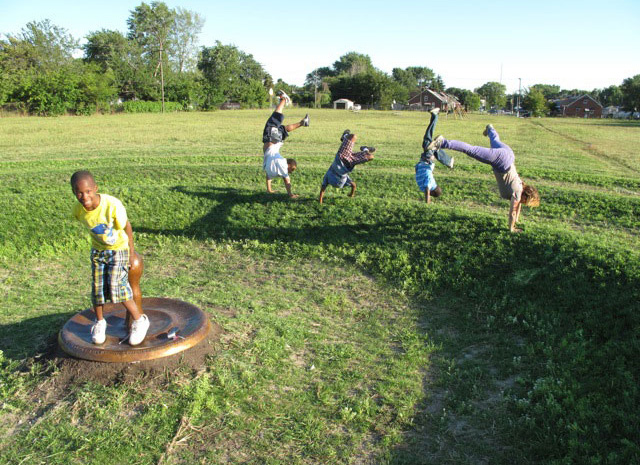
^Graem Whyte and Faina Lerman, Memory Field (2010).
Groundcover, earth, drainage system, cistern, 3′ high x 100′ in diameter. Image courtesy of the artists.
There are so many ways of thinking space – as intimacy (see, for example, the interview with Timothy and Marilyn Mast, on the intimacy of living with a collection of ceramic art long open to artists in Detroit), as ludic invention, as heterotopias, as voids (which can have a creative function akin to redundancy in systems theory), as the envelop of community, as the mark of the anxiety of dispossession as Foucault put it – but above all if space is not to become, yet again, the functional space of urban renewal it must be a practice, a practice of collaborative invention, as the Lettrist International Gil J. Wolman put it: L’espace est une invention: Space is an invention.8Wolman, “Constat d’échec (Notice of failure),” Défense de mourir (Paris: Allia, 2001), 156. Wolman was a co-conspirator with Debord in the … There is never simply space to be managed, this is the functionalist fallacy. As Rilke wrote in “The Eight Elegy,” the poem more than any other in which we find the presentation of the Open,
We’ve never, no, not for a single day,
pure space before us, such as that which flowers
endlessly open into: always world,
and never nowhere without no [Nirgends ohne nicht].9Rainer Maria Rilke, “The Eight Elegy,” The Duino Elegies, trans. J.B. Leishman and Stephen Spender (London: Chatto and Windus, 1963), 77. In a …
Space is always a particular world because the result of the collaborative activity of world-making and projection and as such an activity of negation, the work of the negative from which no human activity is exempt. In Detroit, in its urban fabric, in the self-conscious art emergent from an engagement with a care of the city, there is a poetics and ethic of space which assumes rather than eschews the sedimented, historical layers and tension of this negation through play and representation.
Social Practice cannot be a solution to the larger structural, global problems of spatial justice – art cannot offer solutions to anything of the kind and to think so is merely delusional or childish – rather, Social Practice, as one of the dominant modes of contemporary art-thinking about social and political relation, offers representations of critical alternatives and gestures to what is lacking…It is as citizens that we accomplish the rest.
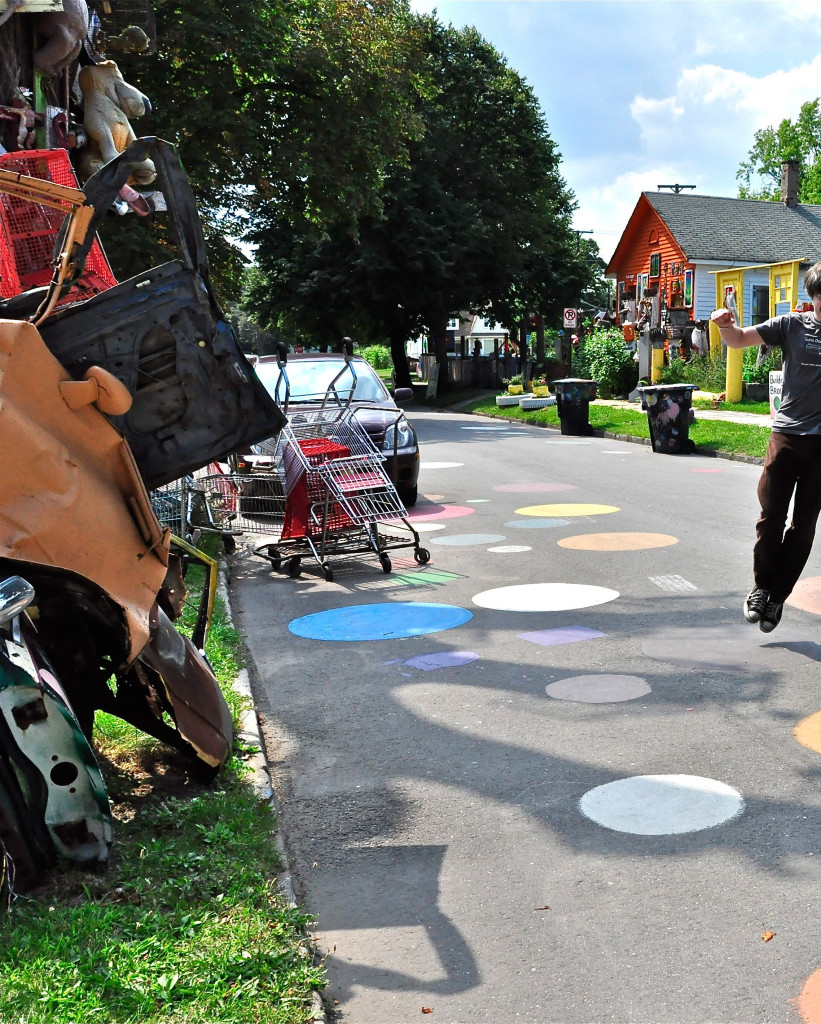
Images from Ride It Sculpture Park (2012-present) and The Heidelberg Project. Courtesy of Vince Carducci.
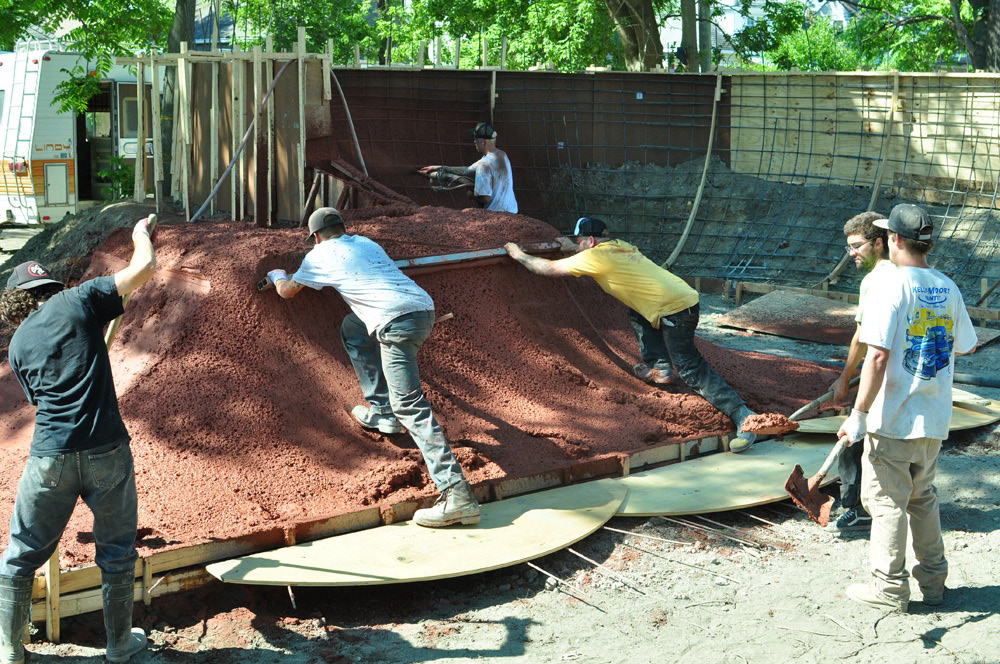
Images from Ride It Sculpture Park (2012-present) and The Heidelberg Project. Courtesy of Vince Carducci.
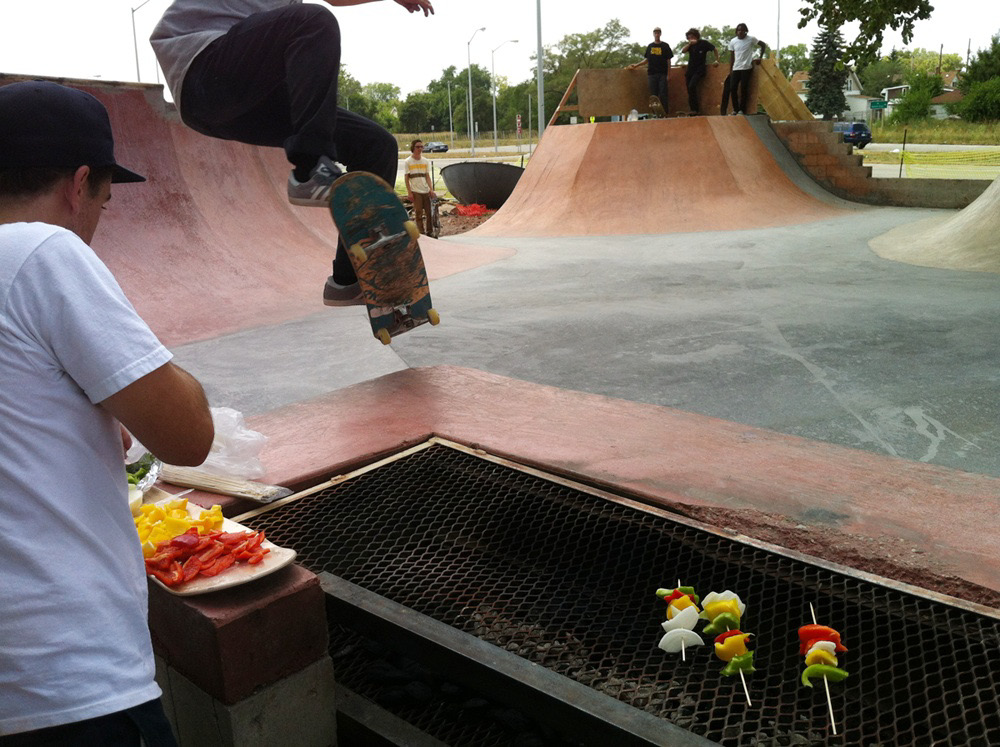
Images from Ride It Sculpture Park (2012-present) and The Heidelberg Project. Courtesy of Vince Carducci.
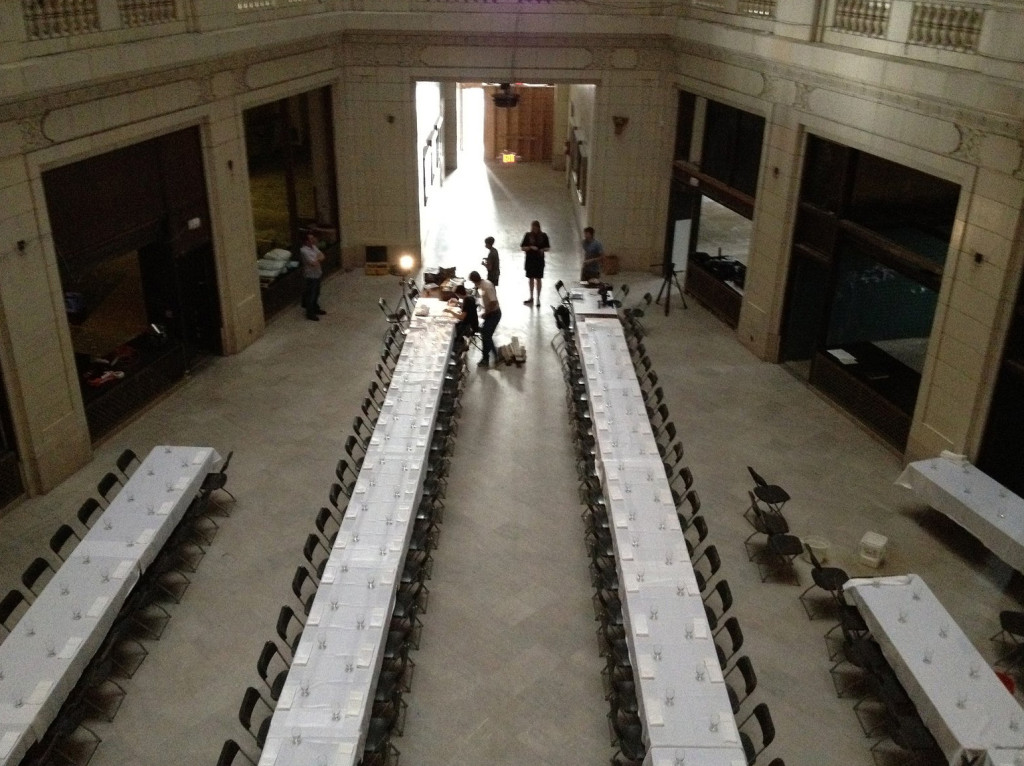
A 250 person Clandestine in the David Whitney Building to raise money for the Ruth Ellis Center. This is before the renovation when there was no running water or electricity. Reopening in 2014. Image courtesy of Phillip Cooley.
References
